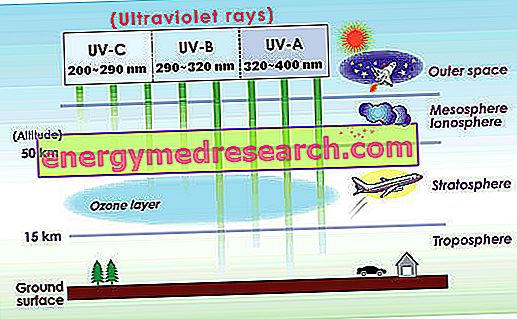Most of the high-energy solar radiation (cosmic rays, gamma rays, UVC and part of the UVB) is retained by the earth's atmosphere. And it is good that this is so because, due to their low wavelength, such radiations would cause serious damage to the human organism.

Center for Global Environmental Research, National Institute for Environmental Studies Japan
UVBs are partly retained by the ozone layer, the troposphere and clouds. When they hit the body they cannot overcome the most superficial layer of the skin, called the epidermis. However, due to the strong energy charge, UVB rays are quite aggressive and stimulate the tan.
UVAs are only minimally retained by the atmosphere and clouds. Compared to UVB they are more penetrating, they do not cause burns and do not actually tan. On the other hand, due to their ability to penetrate to the dermis, they accelerate the processes of skin aging.

The effects of UVA and UVB on skin color are therefore different:
UVAs give the skin an ephemeral coloration, of short duration, due to the oxidation of the melanin already present in the skin at the time of sun exposure. This phenomenon is responsible for the early onset of a slight browning, which appears a few hours after the first summer sun exposure.
If exposure to the sun continues, after a few days UVB causes a progressive coloring, responsible for the actual tan. In fact, UVB radiations stimulate the proliferation of melanosomes, those organelles responsible for melanin production.
The intensity of the UVA that reach the earth's surface remains practically constant throughout the year. The intensity of UVB is instead influenced by different parameters such as season, time of day, altitude and latitude.
The fact that the body is exposed to UVA rays throughout the year and that these radiations are responsible for the photo-aging, suggests the importance of a 360 degree skin protection. Protective creams should in fact be applied not only in summer, but in any occasion in which they are exposed to sunlight.

The body adapts to sun exposure through acute reactions and late reactions. The first group includes erythema (skin reddening due to vasodilation), edema (swelling due to leakage of fluid from the capillaries), blisters and scaling (solar radiation stimulates keratinocyte proliferation, resulting in an increase in desquamation skin).
Late reactions are mainly represented by skin aging (photo-agyng) manifested through elastosis (damage to the fibers in the dermis), wrinkling (appearance of wrinkles), progressive thinning of the skin and telangiectasia (dilatation of more superficial capillaries of the dermis, visible and with a similar appearance to fine sinuous arborescences of bright red or bluish-red color).
The most serious consequence of chronic exposure to solar radiation is the increased incidence of skin cancers. There are two basic types of epidermal cancer: basalioma and melanoma. The first affects the basal cells of the epidermis, manifests itself in uncovered skin areas, is malignant but remains circumscribed (does not cause metastasis). Only if it is neglected can it expand over time to the surrounding tissues.
Melanoma, so called because it affects the melanocytes, is a highly dangerous form of cancer, primarily because it is asymptomatic (it is not painful and does not bleed) and above all because it easily forms metastases. It is essential to take into consideration that melanoma can derive from the malignant transformation of a benign neo. Therefore, especially if moles are tormented manually, a very dangerous neoplastic transformation can occur. Once again the main recommendation is to keep the state of its moles under control, bearing in mind that when these are transformed into melanoma, they take on irregular contours and nuances of various colors.
The skin's reactions to solar radiation depend on the subject's phototype (light-skinned individuals are more sensitive) and the number of phototraumas suffered since childhood.
Artificial tanning (solar lamps) carries the same risk of acute and chronic damage compared to UV rays from the natural source. According to some studies, artificial tanning is slightly more risky, since radiation contains a greater proportion of low-wavelength UVB rays.
The dermis »



